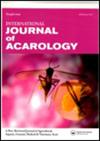First insight into molecular diversity of interstitial water mites (Acari: Hydrachnidia): a case study from the upper Neretva River in Bosnia and Herzegovina
IF 1
3区 农林科学
Q3 ENTOMOLOGY
引用次数: 0
Abstract
ABSTRACTWater mites are a diverse but neglected meiofaunal group in interstitial habitats. In this study, water mites were sampled from the hyporheic zone of the upper Neretva river catchment in Bosnia and Herzegovina. In total, 10 obligate subterranean (hyporheobiontic) species were detected. Seven of them, i.e. Atractidespumilus (Szalay, 1946), Frontipodopsis reticulatifrons Szalay, 1945, Lethaxona pygmaea K. Viets, 1932, Paraxonopsis inferorum (Motaş and Tanasachi, 1947), P. vietsi (Motaş and Tanasachi, 1947), Erebaxonopsis brevipes Motaş and Tanasachi, 1947, and one halacarid species, Parasoldanellonyx typhlops K. Viets, 1933, were recorded for the first time for the fauna of Bosnia and Herzegovina. The first DNA barcoding data are provided for three families (Frontipodopsidae, Lethaxonidae, and Hungarohydracaridae), one subfamily (Stygomomoniinae), and 10 species, providing the first basis for a DNA barcode reference library of water mites from the interstitial habitats in South-Eastern Europe. In each of the four species, considered to have a wide Western Palaearctic distribution, i.e., A. pumilus, F. reticulatifrons, Hungarohydracarus subterraneaus, and Stygomomonia latipes, two separate lineages were distinguished. Fossil-calibrated modelling revealed that the diversification and speciation processes within the above-mentioned species started in the Late Miocene (7.3–11.8 Ma).KEYWORDS: Water mitesDNA-barcodinghyporheic zoneBalkanshyporheobiontic species AcknowledgmentsSpecial thanks to Harry Smit (Alkmaar) whose constructive comments greatly improved this paper. We are indebted to the organizing team of Neretva Science Week for offering the opportunity to study the subterranean fauna. We thank Vojo Milanović and Stefan Andjus for their help with field work, and Gregor Bračko, Annasibila Požrl and Lan Glad Zidar for their help with sorting of the collected material. BR, ŠB, EP, and MZ work was supported by Riverwatch and the organizers of the “Neretva Science Week 2022” and partly by Slovenian Research Agency through core funding P1-0184 and PhD grant to EP. EP was also supported by the University Foundation of eng. Milan Lenarčič. MZ was partly supported by Biodiversa+, the European Biodiversity Partnership under the 2021-2022 BiodivProtect joint call for research proposals, co-funded by the European Commission (GA N°101052342) and with the funding organisations Ministry of Universities and Research (Italy), Agencia Estatal de Investigación – Fundación Biodiversidad (Spain), Fundo Regional para a Ciência e Tecnologia (Portugal), Suomen Akatemia – Ministry of the Environment (Finland), Belgian Science Policy Office (Belgium), Agence Nationale de la Recherche (France), Deutsche Forschungsgemeinschaft e.V. (Germany), Schweizerischer Nationalfonds (Grant N° 31BD30_209583, Switzerland), Fonds zur Förderung der Wissenschaftlichen Forschung (Austria), Ministry of Higher Education, Science and Innovation (Slovenia), and the Executive Agency for Higher Education, Research, Development and Innovation Funding (Romania). This study is part of the “DNA-Eco” scientific project, supported by a grant of the Montenegrin Ministry of Science. We thank two anonymous reviewers, whose constructive comments greatly improved this work.Disclosure statementNo potential conflict of interest was reported by the author(s).首次发现间质水螨(蜱螨目:水蛭目)的分子多样性:以波黑内雷特瓦河上游为例
摘要水螨是一种在间隙生境中分布多样但被忽视的小动物类群。本研究对波黑内雷特瓦河上游集水区的水螨进行了取样。共检测到10种专性地下(低益生)种。其中7种为波黑地区首次记录,分别为:Atractidespumilus (Szalay, 1946)、Frontipodopsis reticulatifrons Szalay, 1945、Lethaxona pygmaea K. viet(1932)、Paraxonopsis interorum (motau和Tanasachi, 1947)、p.v evsi (motau和Tanasachi, 1947)、erebaxonpes motau和Tanasachi(1947)、paroldanellonyx typhlops K. viet(1933)。首次获得了3个科(Frontipodopsidae, Lethaxonidae, Hungarohydracaridae)和1个亚科(Stygomomoniinae) 10个种的DNA条形码数据,为东南欧间隙生境水螨DNA条形码参考文库的建立奠定了基础。在被认为广泛分布于古北西部的四种(即a . pumilus、F. reticulatifrons、Hungarohydracarus subterraneaus和Stygomomonia latipes)中,每一种都有两个独立的谱系。化石校正模型显示,上述物种的多样化和物种形成过程始于晚中新世(7.3-11.8 Ma)。关键词:水虫;dna条形码;疏水带;巴尔干疏水生生学物种。我们非常感谢Neretva科学周的组织团队为我们提供了研究地下动物群的机会。我们感谢Vojo milanoovic和Stefan Andjus对实地工作的帮助,以及Gregor bra ko、Annasibila Požrl和Lan Glad Zidar对收集到的材料进行分类的帮助。BR、ŠB、EP和MZ的工作得到了Riverwatch和“Neretva科学周2022”的组织者的支持,部分由斯洛文尼亚研究机构通过核心资金P1-0184和EP的博士学位资助。本研究亦获大学工程基金资助。米兰Lenarč我č。MZ得到了Biodiversa+的部分支持,Biodiversa+是2021-2022年BiodivProtect联合呼吁下的欧洲生物多样性伙伴关系,由欧盟委员会(GA N°101052342)和资助组织大学和研究部(意大利),Agencia Estatal de Investigación - Fundación Biodiversidad(西班牙),Fundo Regional para a Ciência e Tecnologia(葡萄牙),Suomen Akatemia -环境部(芬兰),比利时科学政策办公室(比利时)、法国国家研究局(法国)、德国Forschungsgemeinschaft e.V(德国)、瑞士国家基金会(瑞士资助号31BD30_209583)、奥地利基金会Förderung der Wissenschaftlichen Forschung(奥地利)、斯洛文尼亚高等教育、科学与创新部(斯洛文尼亚)和罗马尼亚高等教育、研究、发展和创新基金执行机构。这项研究是由黑山科学部资助的“DNA-Eco”科学项目的一部分。我们感谢两位匿名审稿人,他们的建设性意见极大地改进了这项工作。披露声明作者未报告潜在的利益冲突。
本文章由计算机程序翻译,如有差异,请以英文原文为准。
求助全文
约1分钟内获得全文
求助全文
来源期刊
CiteScore
2.20
自引率
9.10%
发文量
60
审稿时长
6-12 weeks
期刊介绍:
The International Journal of Acarology has a global readership and publishes original research and review papers on a wide variety of acarological subjects including:
• mite and tick behavior
• biochemistry
• biology
• control
• ecology
• evolution
• morphology
• physiology
• systematics
• taxonomy (single species descriptions are discouraged unless accompanied by additional new information on ecology, biology, systematics, etc.)
All submitted manuscripts are subject to initial appraisal by the Editor. If the English is not of a quality suitable for reviewers, the manuscript will be returned. If found suitable for further consideration, it will be submitted to peer review by independent, anonymous expert referees. All peer review is single blind.

 求助内容:
求助内容: 应助结果提醒方式:
应助结果提醒方式:


